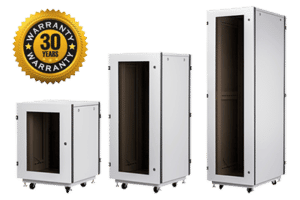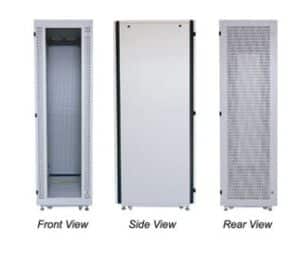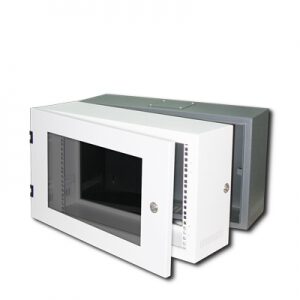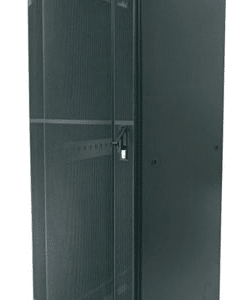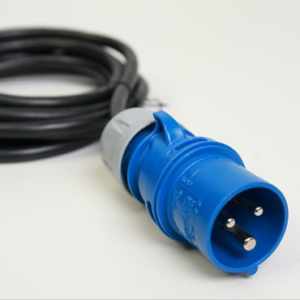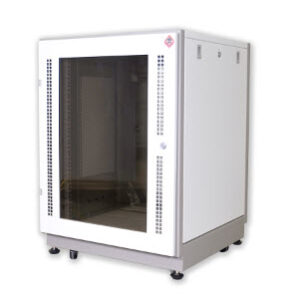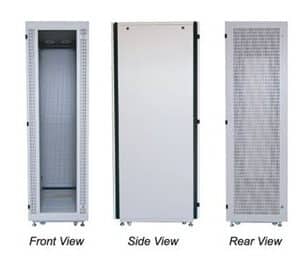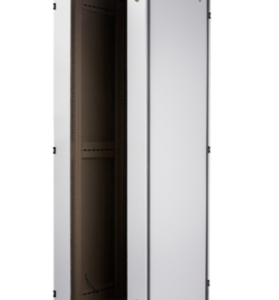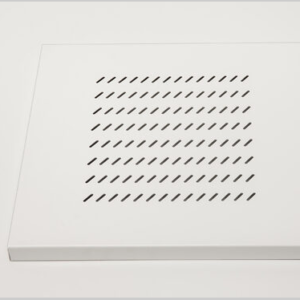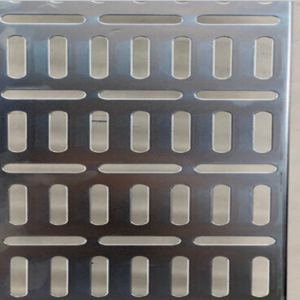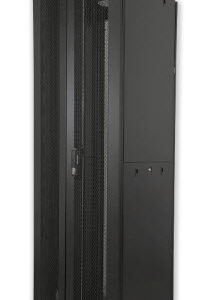เปรียบเทียบตู้แร็ค แบบ close Rack กับ Server Rack แบบไหนดีกว่ากัน
ตู้แร็คแบบ Close Rack (Closed Rack) และ Server Rack เป็นสองแบบของตู้แร็คที่ใช้ในการเก็บอุปกรณ์เครือข่ายและเซิร์ฟเวอร์ โดยทั่วไปแล้วมีความแตกต่างกันดังนี้:
- โครงสร้างและการป้องกัน:
- Close Rack: ตู้แร็คแบบ Close Rack มีโครงสร้างที่มีทั้งด้านหน้าและด้านหลังปิดกันอย่างแน่นหนา มักมีประตูหน้าบานหรือประตูสไลด์สำหรับเข้าถึงอุปกรณ์ภายใน จุดเด่นของ Close Rack คือการป้องกันความรบกวนภายนอก เช่น ฝุ่น สารเคมี และการเข้าถึงที่ไม่ได้รับอนุญาต ทำให้มีระดับความปลอดภัยสูงกว่าในการรักษาข้อมูลและอุปกรณ์ภายในตู้
- Server Rack: ตู้แร็คแบบ Server Rack มักมีโครงสร้างที่เปิดเผยด้านหลังและด้านบน เพื่อให้สามารถเข้าถึงและต่อเพิ่มอุปกรณ์ได้ง่าย จุดเด่นของ Server Rack คือความสะดวกในการติดตั้งและบำรุงรักษาอุปกรณ์ รวมถึงการระบายความร้อนออกจากตู้ได้ดีกว่า
- การระบายความร้อน:
- Close Rack: เนื่องจากโครงสร้างที่ปิดกันแน่นหนา การระบายความร้อนในตู้แร็คแบบ Close Rack จำเป็นต้องใช้ระบบระบายความร้อนเสริม เช่น พัดลมหรือระบบระบายอากาศอื่นๆ เพื่อให้ความร้อนถูกนำออกจากตู้
- Server Rack: ตู้แร็คแบบ Server Rack มีโครงสร้างที่เปิดเผยด้านหลัง ทำให้มีการระบายความร้อนธรรมชาติจากการไหลของอากาศในห้อง เมื่ออุปกรณ์ทำงาน แต่ก็ยังสามารถเพิ่มพัดลมหรือระบบระบายความร้อนเสริมในกรณีที่มีการสะสมความร้อนมากเกินไป
- ความสามารถในการควบคุมและบำรุงรักษา:
- Close Rack: เนื่องจากมีการปิดกั้นอุปกรณ์ภายในตู้แร็ค การเข้าถึงและการบำรุงรักษาอุปกรณ์อาจจำเป็นต้องเปิดประตูหน้าบานหรือถอดอุปกรณ์จากตู้เพื่อเข้าถึง ส่วนการควบคุมอุปกรณ์เช่นเปิด-ปิดเครื่อง อาจต้องทำผ่านระบบการควบคุมที่ติดตั้งภายในตู้
- Server Rack: ตู้แร็คแบบ Server Rack มีความสะดวกในการเข้าถึงและบำรุงรักษาอุปกรณ์ภายใน เนื่องจากมีการเปิดเผยด้านหลังและด้านบน สามารถติดตั้งอุปกรณ์ เปลี่ยนแปลงการเชื่อมต่อ และการบำรุงรักษาได้ง่ายมากกว่า
การเลือกใช้ตู้แร็คแบบ Close Rack หรือ Server Rack ขึ้นอยู่กับความต้องการของผู้ใช้งาน หากคุณมีความสำคัญในเรื่องความปลอดภัยและความเป็นส่วนตัวของอุปกรณ์ และต้องการการควบคุมที่เข้มงวด ความสามารถในการระบายความร้อน และความมั่นคงของระบบ คุณอาจพิจารณาใช้ตู้แร็คแบบ Close Rack แต่ถ้าคุณมีความสำคัญในการเข้าถึงและการบำรุงรักษาที่สะดวก และมีความสำคัญกับความระบายความร้อนที่ดี คุณอาจเลือกใช้ตู้แร็คแบบ Server Rack
A Close Rack server refers to a server that is housed within a closed rack enclosure. The close rack provides a secure and controlled environment for the server, offering protection from physical damage, dust, and unauthorized access.
The Close Rack server setup typically involves installing the server hardware, such as servers, switches, and other networking equipment, into the rack enclosure. The rack is designed with front and rear doors that can be locked to prevent unauthorized access. It also has removable side panels for easy access to the equipment when necessary.
The benefits of using a Close Rack server include:
- Enhanced security: The closed design of the rack provides a higher level of security, preventing unauthorized access to the server and protecting sensitive data.
- Physical protection: The rack enclosure protects the server from physical damage, such as accidental bumps or impact, and reduces the risk of dust or debris entering the system.
- Cable management: Close Racks often feature built-in cable management systems, such as cable trays and vertical cable managers, which help organize and route cables neatly, improving airflow and reducing cable clutter.
- Improved cooling: Close Racks typically have provisions for airflow management, including front-to-back or bottom-to-top ventilation, allowing for better cooling efficiency and heat dissipation within the enclosure.
- Space optimization: Close Racks are designed to maximize the use of space by providing standardized rack units (U) for equipment installation, enabling efficient stacking and arrangement of servers and networking devices.
It's important to note that the choice between a Close Rack server and an open Server Rack depends on specific requirements, security concerns, environmental factors, and the level of access and control needed for the server infrastructure.


